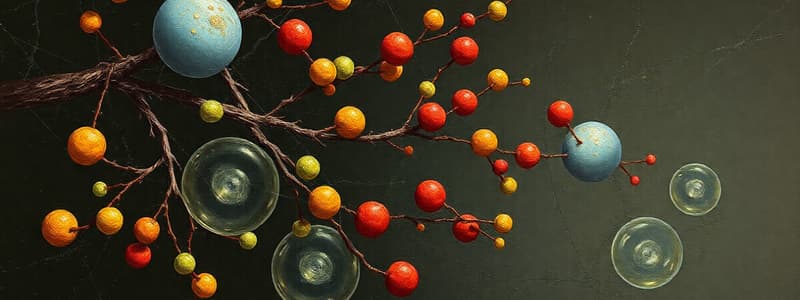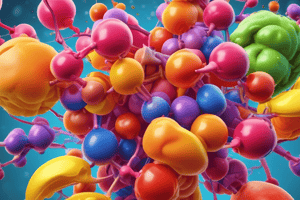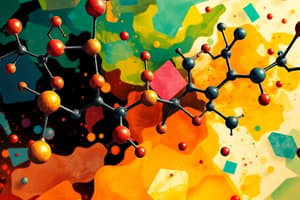Podcast
Questions and Answers
What is the primary function of carbohydrates in the body?
What is the primary function of carbohydrates in the body?
- To provide insulation
- To aid in digestion
- To provide energy (correct)
- To store genetic information
Which type of carbohydrate is formed by the combination of two simple sugars?
Which type of carbohydrate is formed by the combination of two simple sugars?
- Monosaccharide
- Polysaccharide
- Oligosaccharide
- Disaccharide (correct)
What determines the final shape of a protein?
What determines the final shape of a protein?
- The length of the protein chain
- The type of amino acids present
- The interaction and arrangement of R-groups (correct)
- The temperature of the surrounding environment
Which macromolecule is primarily responsible for building body tissues and supporting immunity?
Which macromolecule is primarily responsible for building body tissues and supporting immunity?
What defines a monosaccharide?
What defines a monosaccharide?
What process connects monomers to form carbohydrates?
What process connects monomers to form carbohydrates?
Which of the following correctly describes vitamins?
Which of the following correctly describes vitamins?
What are the two structural components of fats?
What are the two structural components of fats?
What distinguishes saturated fatty acids from unsaturated fatty acids?
What distinguishes saturated fatty acids from unsaturated fatty acids?
Which polysaccharide is known to be difficult for the human body to break down?
Which polysaccharide is known to be difficult for the human body to break down?
What is the primary function of minerals within the body?
What is the primary function of minerals within the body?
Which type of lipid remains solid at room temperature?
Which type of lipid remains solid at room temperature?
In which form do animals primarily store carbohydrates?
In which form do animals primarily store carbohydrates?
In which of the following is keratin primarily involved?
In which of the following is keratin primarily involved?
What is the primary role of lipids in the body?
What is the primary role of lipids in the body?
Where are carbohydrates primarily found?
Where are carbohydrates primarily found?
What happens to carbohydrates that are not immediately used by the body?
What happens to carbohydrates that are not immediately used by the body?
What process converts unsaturated fats into saturated fats?
What process converts unsaturated fats into saturated fats?
What do proteins NOT primarily provide for our cells?
What do proteins NOT primarily provide for our cells?
Which type of bonds connect amino acids in proteins?
Which type of bonds connect amino acids in proteins?
How many amino acids are essential and must be obtained through diet?
How many amino acids are essential and must be obtained through diet?
What is the primary role of inhibitors in enzymatic reactions?
What is the primary role of inhibitors in enzymatic reactions?
How do competitive inhibitors function in enzymatic reactions?
How do competitive inhibitors function in enzymatic reactions?
Which statement accurately describes non-competitive inhibitors?
Which statement accurately describes non-competitive inhibitors?
What is a characteristic of enzymes as protein catalysts?
What is a characteristic of enzymes as protein catalysts?
What happens to enzyme activity as more product is created by an enzymatic reaction?
What happens to enzyme activity as more product is created by an enzymatic reaction?
What is an enzyme primarily classified as?
What is an enzyme primarily classified as?
Which model describes how an enzyme and substrate fit together perfectly?
Which model describes how an enzyme and substrate fit together perfectly?
What effect does increasing substrate concentration have on enzyme activity?
What effect does increasing substrate concentration have on enzyme activity?
What is the role of a cofactor in enzyme activity?
What is the role of a cofactor in enzyme activity?
What is the optimal pH range for most human enzymes?
What is the optimal pH range for most human enzymes?
Which term describes the specific area of an enzyme that combines with the substrate?
Which term describes the specific area of an enzyme that combines with the substrate?
What type of molecule is a coenzyme typically derived from?
What type of molecule is a coenzyme typically derived from?
What happens to an enzyme at temperatures beyond its optimal range?
What happens to an enzyme at temperatures beyond its optimal range?
Flashcards
Macromolecules
Macromolecules
Large, complex organic molecules found in living organisms
Carbohydrates
Carbohydrates
Macromolecules primarily for energy. Composed of carbon, hydrogen, and oxygen.
Monosaccharides
Monosaccharides
Simple sugars, smallest unit of carbohydrates.
Disaccharides
Disaccharides
Signup and view all the flashcards
Polysaccharides
Polysaccharides
Signup and view all the flashcards
Dehydration Synthesis
Dehydration Synthesis
Signup and view all the flashcards
Hydrolysis
Hydrolysis
Signup and view all the flashcards
Primary function of carbohydrates
Primary function of carbohydrates
Signup and view all the flashcards
Protein Shape
Protein Shape
Signup and view all the flashcards
Charged R-groups
Charged R-groups
Signup and view all the flashcards
Uncharged R-groups
Uncharged R-groups
Signup and view all the flashcards
Proteins: Main Function
Proteins: Main Function
Signup and view all the flashcards
What are Vitamins?
What are Vitamins?
Signup and view all the flashcards
Why limit carbs?
Why limit carbs?
Signup and view all the flashcards
Starch vs. Cellulose: Similarities
Starch vs. Cellulose: Similarities
Signup and view all the flashcards
Starch vs. Cellulose: Differences
Starch vs. Cellulose: Differences
Signup and view all the flashcards
Lipid Composition
Lipid Composition
Signup and view all the flashcards
Saturated vs. Unsaturated Fats
Saturated vs. Unsaturated Fats
Signup and view all the flashcards
Hydrogenation
Hydrogenation
Signup and view all the flashcards
Protein Function
Protein Function
Signup and view all the flashcards
Essential Amino Acids
Essential Amino Acids
Signup and view all the flashcards
Enzyme
Enzyme
Signup and view all the flashcards
Catalyst
Catalyst
Signup and view all the flashcards
Substrate
Substrate
Signup and view all the flashcards
Active Site
Active Site
Signup and view all the flashcards
Enzyme Inhibitors
Enzyme Inhibitors
Signup and view all the flashcards
Competitive Inhibitor
Competitive Inhibitor
Signup and view all the flashcards
Cofactor
Cofactor
Signup and view all the flashcards
Coenzyme
Coenzyme
Signup and view all the flashcards
Non-competitive Inhibitor
Non-competitive Inhibitor
Signup and view all the flashcards
Lock and Key Model
Lock and Key Model
Signup and view all the flashcards
What does an inhibitor do to the enzyme's activity?
What does an inhibitor do to the enzyme's activity?
Signup and view all the flashcards
Induced Fit model
Induced Fit model
Signup and view all the flashcards
Why are enzyme inhibitors important?
Why are enzyme inhibitors important?
Signup and view all the flashcards
Study Notes
D1.1 - Molecules of Living Systems
- Molecules of living systems are called macromolecules
- The majority of compounds found in food fall into three categories—carbohydrates, lipids, and proteins
- Macromolecules are made of smaller subunits
- Macromolecules are assembled through dehydration synthesis
- Macromolecules are broken down through hydrolysis
- Carbohydrates are primarily for providing energy for the body
- Carbohydrates are necessary for energy and found in plant-based foods (fruits, vegetables, grains)
- Carbohydrates are made up of carbon (C), oxygen (O), and hydrogen (H)
- They contain two hydrogen atoms and one oxygen atom for every carbon atom
- Carbohydrates can be classified as monosaccharides, disaccharides, or polysaccharides
- Monosaccharides have 3-7 carbon atoms (e.g., fructose, glucose, galactose)
- Disaccharides are made up of two simple sugars linked together through dehydration synthesis (e.g., sucrose, maltose, lactose)
- Polysaccharides are long chains of simple sugars (e.g., starch, cellulose)
- Cellulose is difficult to break down
- Animals store carbohydrates in the form of glycogen
- Over 50% of organic carbon in biosphere is tied up as cellulose
Lipids
- Lipids consist of glycerol (3-carbon chain) and fatty acids
- Fats are lipids composed of glycerol and saturated fatty acids, solid at room temperature
- Oils are lipids composed of glycerol and unsaturated fatty acids, liquid at room temperature
- Lipids are insoluble in water
- Lipids are found in foods containing animal- or plant-based oils/fats
- Function as long-term energy storage molecules
- Other lipids (phospholipids) form membranes that separate cells from their internal environment
- Some lipids carry vitamins, are steroids, and play a role in hormone synthesis
- Saturated fatty acids have only single carbon-carbon bonds, have maximum hydrogen, and are solid at room temperature (e.g. butter)
- Unsaturated fatty acids have at least one double carbon-carbon bond, have less hydrogen, and are liquid at room temperature (e.g. oil)
- Hydrogenation converts unsaturated fats into saturated fats by breaking double bonds and adding hydrogen
Proteins
- Proteins are formed by amino acid molecules bonded together in long chains by peptide bonds
- Proteins do not provide energy for our cells.
- Proteins play many vital functions in our bodies including forming structural components, repairing damage, speeding up chemical reactions (enzymes) and defending against disease (antibodies)
- There are 20 amino acids and 8 must be obtained through eating, the rest are synthesized
- Proteins are found in meat, eggs, dairy products, and legumes
- Solubility of proteins is determined by the type of R-group, charged attract water and are soluble
- Proteins have different structures from primary to quaternary structure
- Lysozyme is an enzyme found in nasal fluid and tears, killing bacteria.
- Integrin creates connections between structures inside and outside the cell
- Collagen is a structural protein in tendons, ligaments, blood vessels and skin
- Hemoglobin allows red blood cells to carry oxygen.
Vitamins and Minerals
- Vitamins are organic compounds that often help enzymes function and are needed in small amounts for tissue development, growth, and resistance to disease
- Examples include Vitamin D and Vitamin B12
- Minerals are inorganic compounds needed in small amounts by the body that help build bones, cartilage, and chemical reactions
- Potassium is an example of a mineral found in bananas
Enzymes
- Enzymes are protein catalysts that permit chemical reactions to process at low temperatures
- Enzymes reduce the energy required to react
- Enzymes are not used up in the reaction
- The name of the enzyme identifies the molecule it targets (e.g., lactase targets lactose)
- Two types of models for enzymes, lock-and-key and induced fit
- Factors influencing enzymes include temperature, pH, and substrate concentration
- Inhibitors attach to enzymes, reducing their ability to bond to substrates (competitive and non-competitive)
Studying That Suits You
Use AI to generate personalized quizzes and flashcards to suit your learning preferences.
Related Documents
Description
Explore the essential molecules of living systems in this quiz focused on macromolecules like carbohydrates, lipids, and proteins. Understand how these macromolecules are formed and broken down, and their vital roles in providing energy and structure to organisms. Perfect for students looking to solidify their knowledge of biological compounds.




